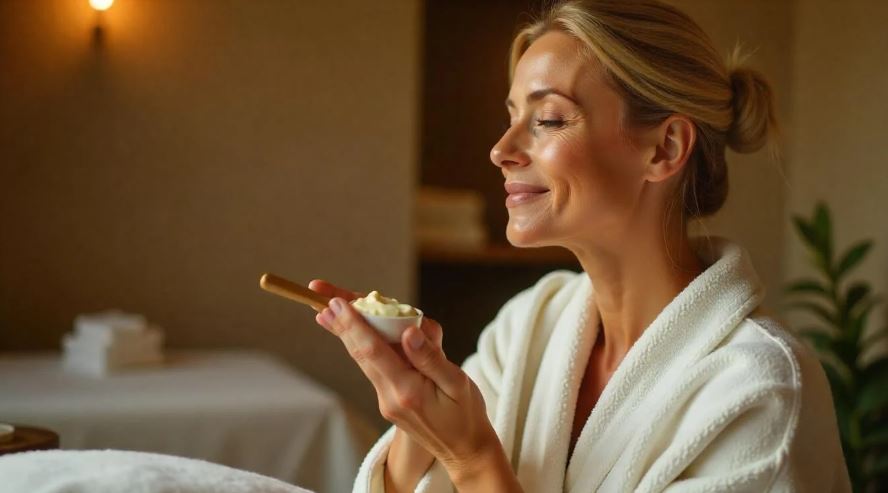Few ingredients have garnered as much acclaim in natural skincare as raw shea butter. Extracted from the nuts of the African shea tree (Vitellaria paradoxa), this rich, ivory-colored substance has been a cornerstone in beauty and wellness routines for centuries. Celebrated for its intense moisturizing and healing properties, raw shea butter addresses many skin and hair concerns, from dryness and irritation to signs of aging. Its versatility and efficacy make it a staple for those seeking natural, chemical-free solutions in their personal care regimen.
What Is Raw Shea Butter?
Raw shea butter is the unrefined fat obtained from the nuts of the African shea tree. Unlike its refined counterparts, raw shea butter undergoes minimal processing, retaining all its natural vitamins, minerals, and healing compounds. This preservation ensures the butter maintains its potent properties, making it highly effective for various applications.
The extraction process involves harvesting shea nuts, drying them, and then grinding them into a paste. This paste is then kneaded and boiled to separate the oils, solidifying into butter upon cooling. The result is a creamy, off-white, yellowish substance with a distinctive nutty aroma.
Rich in vitamins A, E, and F, as well as essential fatty acids such as oleic, stearic, palmitic, and linoleic acids, raw shea butter offers profound moisturizing, anti-inflammatory, and antioxidant benefits. Its unique composition makes it suitable for various uses, from skincare and haircare to therapeutic applications.
Skin and Hair Benefits of Raw Shea Butter
- Deep Moisturization
Shea butter's high concentration of fatty acids and vitamins makes it an excellent emollient and humectant. It penetrates deeply into the skin, restoring lipids and creating a moisture-sealing barrier. This property is particularly beneficial for individuals with dry skin, as it helps maintain optimal hydration levels.
- Anti-Aging Properties
Shea butter contains antioxidants, notably vitamins A and E, which help neutralize free radicals, which are responsible for premature skin aging. Regular application can enhance collagen production, improve skin elasticity, and reduce the appearance of fine lines and wrinkles.
- Soothes Irritation and Inflammation
Shea butter exhibits anti-inflammatory properties, making it effective in calming irritated skin. It can alleviate conditions such as eczema, psoriasis, and dermatitis by reducing redness and swelling. Its soothing nature also suits it for treating sunburns and minor skin abrasions.
- Natural Sun Protection
While not a substitute for sunscreen, shea butter offers a mild sun protection factor (SPF) of approximately 3 to 4. When used in conjunction with other sun protection measures, this provides an added layer of defense against UV rays.
- Scar and Stretch Mark Reduction
Shea butter promotes skin regeneration and healing, which can diminish the appearance of scars and stretch marks over time. Its moisturizing effect enhances skin elasticity, preventing the formation of new stretch marks during periods of rapid growth or weight changes.
- Hair Care Benefits
Beyond skincare, shea butter is a valuable ingredient for hair care. It moisturizes the scalp, reduces dandruff, and strengthens hair strands, preventing breakage. Its emollient properties help tame frizz and add shine, making it suitable for a variety of hair types and textures.
Yellow vs. White Raw Shea Butter: Understanding the Differences
When selecting raw shea butter, consumers often encounter two primary variants: yellow and white. Both types offer similar benefits but differ in appearance, processing, and specific characteristics.
- Color and Additives: The yellow hue typically results from the addition of natural colorants, such as the Borututu root, during processing. This root imparts color and may enhance the butter's anti-inflammatory properties.
- Texture and Aroma: Yellow shea butter often has a smoother, creamier texture and retains a more pungent nutty scent, indicating its unrefined nature.
- Nutrient Content: Because it is less processed, it retains a higher concentration of vitamins and nutrients, making it a potent option for therapeutic uses.

- Color and Processing: White shea butter undergoes a filtration process to remove impurities, resulting in a lighter, off-white color. This process may slightly reduce its nutrient content.
- Texture and Aroma: It has a milder scent and a slightly grainier texture than its yellow counterpart.
- Usage: Due to its neutral color and scent, white shea butter is often preferred in cosmetic formulations containing additional fragrances or colors.

Choosing Between the Two
The choice between yellow and white shea butter largely depends on personal preference and intended use. Yellow shea butter is ideal for those seeking maximum potency and a natural experience. Conversely, white shea butter suits individuals looking for a more neutral base for DIY skincare products or those sensitive to strong scents.
Everyday Uses of Raw Shea Butter
- Facial Moisturizer
Apply a small amount of shea butter to the face after cleansing to lock in moisture. Its non-comedogenic nature ensures it hydrates without clogging pores, making it suitable for most skin types.
- Body Lotion
Use shea butter as a full-body moisturizer to combat dryness, especially on elbows, knees, and heels. Its rich texture provides lasting hydration throughout the day.
- Lip Balm
Shea butter's emollient properties make it an effective remedy for chapped lips. Apply directly or incorporate it into homemade lip balm recipes for soft, supple lips.
- Hair Conditioner
Melt shea butter and apply it to the hair as a deep-conditioning treatment. Leave it on for 30 minutes before washing to nourish and strengthen hair strands.
- Scalp Treatment
Massage shea butter into the scalp to alleviate dryness and flakiness. Its anti-inflammatory properties can soothe irritation and promote a healthy scalp environment.
- Baby Care
Given its gentle nature, shea butter is safe for use on babies. It can treat diaper rash, dry patches, and minor skin irritations.
- Massage Balm
Combine shea butter with essential oils to create a soothing massage balm. Its smooth texture allows for easy application and absorption during massages.
Selecting and Storing Raw Shea Butter
Selecting Quality Shea Butter
- Purity: Opt for products labeled as "100% pure," "unrefined," or "Grade A" to ensure minimal processing and maximum nutrient retention.
- Color and Scent: Authentic raw shea butter should be natural off-white to yellowish in color and have a nutty aroma. A lack of scent or an overly white appearance may indicate over-processing.
- Texture: High-quality shea butter should be smooth and creamy, melting upon contact with the skin.
Storage Tips
- Container: Store shea butter in an airtight container to prevent contamination and oxidation.
- Environment: To maintain its consistency and efficacy, keep it in a cool, dry place away from direct sunlight and heat sources.
- Shelf Life: When stored properly, raw shea butter can last up to two years without losing its beneficial properties.
Conclusion: Embracing the Raw Goodness
Raw shea butter is a testament to nature's ability to provide practical solutions for skin and hair care. Its rich composition of vitamins, fatty acids, and antioxidants offers numerous benefits, including deep hydration, anti-aging effects, soothing irritated skin, and strengthening hair. Whether you choose the vibrant yellow variant or the neutral white, incorporating raw shea butter into your daily routine can lead to healthier, more radiant skin and hair. Embrace this natural wonder and experience its transformative effects on your personal care regimen.
FAQs
- What is the difference between yellow and white raw shea butter?
Yellow shea butter typically contains natural colorants, such as Borututu root, which gives it a vibrant hue and potentially enhances its anti-inflammatory properties. White shea butter undergoes filtration to remove impurities, resulting in a lighter color and milder scent. Both variants offer similar moisturizing benefits, and the choice depends on personal preference and intended use.
- Is raw shea butter safe for sensitive skin?
Due to its natural composition and lack of additives, raw shea butter is generally safe for sensitive skin. However, a patch test is advisable before widespread application to ensure that no allergic reactions occur.
- Can raw shea butter be used on the face daily?
Absolutely. Raw shea butter can be an effective daily facial moisturizer when used in moderation. Its non-comedogenic nature ensures it hydrates without clogging pores, making it suitable for most skin types.
- Does shea butter clog pores?
Shea butter is considered non-comedogenic, meaning it doesn't clog pores for most individuals. However, those with acne-prone or oily skin should monitor their skin's response and adjust usage accordingly.
- How can I tell if my shea butter has gone bad?
Signs of expired shea butter include a rancid or sour smell, changes in color, and a gritty texture. Proper storage in a cool, dry place can extend its shelf life to two years.

